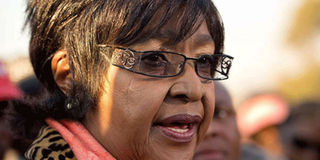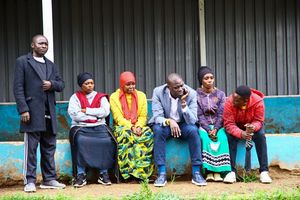Remembering Winnie Madikizela as a young woman

Winnie Madikizela-Mandela speaks to the media outside her first family home in Soweto, South Africa, on June 28, 2013. PHOTO | ODD ANDERSEN | AFP
What you need to know:
- One of the key themes that began to emerge after Winnie Madikizela's death was her relationship with Nelson Mandela.
- As was the case during her lifetime, there’s still an overarching assumption that her politics was shaped by her husband.
- Before she met Mandela, she became more involved within the broad African National Congress (ANC) networks and the work of the ANC Women’s League.
- Her achievements weren’t rare just for a black South African woman in a racist society; they were highly unusual for any woman regardless of class and race in the society at that time.
Within hours of Winnie Madikizela death debates about her life began to rage. One of the key themes that began to emerge was her relationship with Nelson Mandela. As was the case during her lifetime, there’s still an overarching assumption that her politics was shaped by her husband.
Of course a partner of 38 years, even mainly in absentia as he was imprisoned for 27, would have some influence over a person’s life. But reducing Madikizela's entire life and legacy to her relationship with Mandela has more to do with patriarchal narratives about powerful women than reality.

In this file photo taken on July 27, 1987, Winnie Mandela raises a clenched fist as she attends with Sello Motau's mother (R) the funeral of Sello Motau, senior member of the "Umkhonto We Sizwe" (Spear of the Nation), the ANC military wing, who was gunned down in Swaziland on July 9, 1987. PHOTO | WALTER DHLADHLA |AFP
THE BEGINNING
So who was Nomzamo Winifred Madikizela, and what shaped her?
She was born on 26 September 1936, the last in a family of four daughters in a part of South Africa – the Eastern Cape – that had already experienced several waves of subjugation, some more effective than others.
Forty years earlier the Glen Grey Act had been passed which led to the annexation of the Transkei and Pondolond under the control of the Cape Colony. It was the culmination of several attempts to seize the rich agricultural land of the Eastern Cape over more than 100 years.
The draconian measures put in place by the colonial state to bring the region under control were not completely successful. The indomitable spirit of resistance forged over centuries of conflict made it impossible to fully subjugate the people of this region.

A portrait of South African anti-apartheid campaigner Winnie Madikizela-Mandela hangs in the house museum that Winnie Mandela shared with her husband Nelson Mandela in Soweto, outside of Johannesburg, on April 3, 2018. PHOTO | MARCO LONGARI | AFP
By the time the Union of South Africa was established in 1910 it became clear that more controls were needed to smash resistance to land appropriation by white settlers. In 1913 the Union state passed the inhuman Natives Land Act. With this act, the South African state prohibited Africans from owning and renting land in 93% of the country. It laid the groundwork for massive segregation.
The various waves of subjugation from colonial wars, skirmishes and laws, missionaries, encroachment of settlers and the mass expropriation of land meant that even the lush bountiful valleys of the Transkei were made poor. Men were then forced into migrant labour on the golden reefs of Witwatersrand.
Madikizela was born into this contested space and into a family of accomplished women who encouraged open questioning about oppression.

A picture taken on April 15, 1986 shows Winnie Madikizela-Mandela meeting with former German Chancellor Willy Brandt in Johannesburg, South Africa. PHOTO | GIDEON MENDEL | AFP
ANCESTORS
Madikizela’s grandfather, Chief Mazingi, was a prosperous man who owned a trading store as well as a well-functioning farm. He held onto certain customs and social norms but was also open to change. The Methodist missionaries established in the area made a strong impression on him.
Madikizela was also descendent from a line of powerful women. Her paternal grandmother, Seyina, for example, inherited her husband’s vast land holdings after his death. She also continued running the trading post and leased land to white settlers.
Gertrude Mzaidume, Madikizela’s mother, was another accomplished woman. She was the first domestic science teacher in Bizana. An exceptionally beautiful woman, she was very particular about her appearance, a trait that Madikizela inherited. Gertrude was a disciplinarian and strictly adhered to her Methodist values. Madikizela called her mother “a religious fanatic” and attributed her teenage rebellion against the church to her mother’s religious discipline.

In this file photo taken on April 17, 1995 Winnie Mandela reads her statement at her home in Soweto during a media conference to announce her resignation as deputy minister of arts, culture, science and technology. PHOTO | WALTER DHLADHLA | AFP
Madikizela’s father, Columbus, was a schoolteacher. He and his siblings embraced the various changes sweeping through their part of the world while also maintaining a strong connection to local traditions and customs. His relationship with Christianity was ambivalent.
This distrust of settler society, culture and religion meant Madikizela grew up in a space that was always open to questioning oppression. Madikizela’s father was her first teacher; he taught her history from textbooks as well as history that didn’t feature in the books.
In her biography Part of my Soul, Madikizela recalled her father using songs to teach her about the Eastern Cape’s colonial subjugation through a series of wars.

In this file photo taken on December 16, 2017 then-South African President Jacob Zuma, Winnie Mandela and then-Deputy President Cyril Ramaphosa hug as they attend the 54th ANC National Conference at the NASREC Expo Centre in Johannesburg. PHOTO | MUJAHID SAFODIEN | AFP
POLITICAL AWAKENING
Madikizela’s young life was marked by two major events. When she was about 10, one of her elder sister’s died. Then her mother passed away. In an unconventional move for the time, Columbus refused to send his children to live with other relatives. Instead he kept his family together and, with significant help from Madikizela, ran his own homestead.
Eventually, after almost a year of staying at home, Madikizela returned to school in Flagstaff. Later she went to Shawbury College, a Methodist mission school, to complete her last two years of secondary school.

Winnie Mandela clenches her fist on September 20, 1990 after her husband Nelson Mandela's address at a funeral of 12 people died during violence in Soweto. PHOTO | ALEXANDER JOE | AFP
Her political education continued. Shawbury’s teachers were politically inclined, though this was more theoretical than practical in nature. Madikizela recalled that the teachers – despite being politically aloof – were still admired for introducing radical political ideas into the student body.
Madikizela’s interest in politics and liberation meant that she, like many before her – and many today – faced the difficult choice of entering into the political agitation at her school or persevering with her studies.

Winnie Madikizela-Mandela addresses a meeting in Kagiso township on April 13, 1986. PHOTO | GIDEON MENDEL | AFP
In 1952 people across the country were participating in the Defiance Campaign – a series of coordinated strikes, mass action campaigns, boycotts, and civil disobedience. Madikizela desperately wanted to join the protests, but also keenly felt the sacrifices her family had borne to give her the opportunity to educate herself. She reluctantly sat the protest out and completed her studies.
In 1953 she moved to Johannesburg to study social work. She quickly realised that the city of gold was built on the severe exploitation and oppression of black South Africans. Through her work as a young social worker she was exposed to inhumane conditions faced by the black working class: uninhabitable homes, poor sanitation, a lack of security and high infant mortality rates.

Members of the ANC Women's League gather to pay tribute to late South African anti-apartheid campaigner Winnie Madikizela-Mandela outside her Orlando Soweto house, on the outskirts of Johannesburg on April 3, 2018. PHOTO | MARCO LONGARI | AFP
ACHIEVEMENTS
Her commitment to their struggles saw her turn down a prestigious scholarship to study at a university in Boston. Instead she joined the staff of Baragwanath Hospital as the country’s first black woman social worker.
During this period she became more involved within the broad African National Congress (ANC) networks and the work of the ANC Women’s League.

Members of the ANC Women's League place flowers to pay tribute to late South African anti-apartheid campaigner Winnie Madikizela-Mandela outside her Orlando Soweto house, on the outskirts of Johannesburg on April 3, 2018. PHOTO | MARCO LONGARI | AFP
As we recall Madikizela’s life it’s important to remember that in 1957 – by the age of just 21 and before she met Mandela – she was already extremely accomplished.
Her achievements weren’t rare just for a black South African woman in a racist society; they were highly unusual for any woman regardless of class and race in the society at that time.





